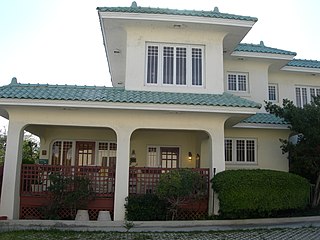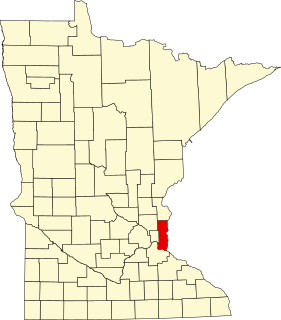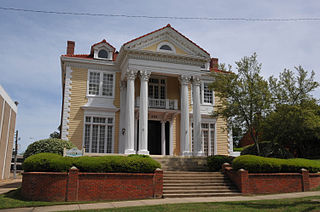This is a list of properties and districts in Mississippi that are listed on the National Register of Historic Places. There are 1,407 sites distributed among all of Mississippi's 82 counties.

The King Edward Hotel, built in 1923 as the Edwards Hotel, is an historic hotel in downtown Jackson, Mississippi. The second of two buildings located on the site at the corner of Capitol and Mill Streets, it was closed and vacant for nearly 40 years before renovations began in 2006. The hotel was listed on the National Register of Historic Places in 1976, and declared a Mississippi Landmark in 1990. It was restored from 2007-2009 as a combination of apartments and the Hilton Garden Inn Jackson Downtown, which opened on December 17, 2009. It features the King Edward Grill, King Edward Bar, Pavilion Pantry convenience mart, Seattle's Best Coffee shop, and a fitness center.

The Sam Gilliam House is a historic home in Fort Lauderdale, Florida. It is located at 11 Southwest 15th Street. On March 29, 2001, it was added to the U.S. National Register of Historic Places.

Monmouth is a historic antebellum home located at 1358 John A. Quitman Boulevard in Natchez, Mississippi on a 26-acre (11 ha) lot. It was built in 1818 by John Hankinson, and renovated about 1853 by John A. Quitman, a former Governor of Mississippi and well-known figure in the Mexican-American War. It is one of Natchez's grandest Greek Revival mansions. It was declared a Mississippi Landmark in 1986 and a National Historic Landmark in 1988. It is now a small luxury hotel.

This is a list of the National Register of Historic Places listings in Butler County, Ohio.

This is a list of the National Register of Historic Places listings in Monterey County, California.

This is a list of the National Register of Historic Places listings in Washington County, Minnesota. It is intended to be a complete list of the properties and districts on the National Register of Historic Places in Washington County, Minnesota, United States. The locations of National Register properties and districts for which the latitude and longitude coordinates are included below, may be seen in an online map.

Griffin House in Moss Point, Mississippi is a Greek Revival building built in the mid-1800s. It is located on a 50-acre (20 ha) property overlooking the joining of the Pascagoula River and the Escatawpa River, about 5 miles (8.0 km) in from the outlet of the Pascagoula to the Gulf of Mexico. It was listed on the National Register of Historic Places in 1983.

The Prospect Park Historic District in Davenport, Iowa, United States, is a historic district that was listed on the National Register of Historic Places in 1984. In its 23.2-acre (9.4 ha) area, it included 23 contributing buildings in 1984. The Prospect Park hill was listed on the Davenport Register of Historic Properties in 1993.

The Samuel Van Sant House is an historic building located in Le Claire, Iowa, United States. The house was built in 1860 and it has been listed on the National Register of Historic Places since 1979. The property is part of the Houses of Mississippi River Men Thematic Resource, which covers the homes of men from LeClaire who worked on the Mississippi River as riverboat captains, pilots, builders and owners. It is also a contributing property in the Cody Road Historic District.
George and Thomas Weldon, also known as the Weldon Brothers, were brothers from Antrim, Ireland who worked as builders in Mississippi.

Fairview Farm is a historic home located near Front Royal, Warren County, Virginia. It was built during the last quarter of the 18th century, and is a two-story, nearly square, timber frame dwelling. It has a hipped roof and two exterior chimneys. It also has two-story porches rebuilt during the restoration in 1984.

Merrill-Maley House is a historic mansion in Jackson, Mississippi, U.S..

The Joseph Henry Morris House is a historic mansion in Jackson, Mississippi, U.S.. It was built in 1891-1893 for Joseph Henry Morris, a veteran of the Confederate States Army during the American Civil War who later worked as an "agent" for the Illinois Central Railroad and founded an ice company. The Morris family had owned the land for generations. It was designed in the Classical Revival architectural style. It has been listed on the National Register of Historic Places since August 11, 1983.

The Millsaps-Buie House is a historic mansion in Jackson, Mississippi, U.S.. It was built for Major Reuben Webster Millsaps, a veteran of the Confederate States Army during the American Civil War who became a wealthy cotton broker and banker after the war. It was inherited by his nephew, Webster Millsaps Buie, in 1916. The house was designed in the Queen Anne architectural style. It has been listed on the National Register of Historic Places since June 19, 1973.

The Ervin Lewis House is a historic mansion in Byram, Mississippi, U.S.. It was built for John Coon prior to the American Civil War As Coon came from the North, the Union Army did not destroy it during the war. It was purchased by Ervin Lewis, who was from South Carolina, after the war. It was designed in the Greek Revival architectural style. It has been listed on the National Register of Historic Places since December 1, 1989.

Castle Crest, also known as the Merrill-Sanders-Holman House, is a historic mansion in Jackson, Mississippi, U.S.. It was built for businessman I.W. Merrill in 1929-1930. By 1980, it belonged to Henry Holman and his wife Sondra. The house was designed in the Tudor Revival style by architect Joe Frazer Smith. It has been listed on the National Register of Historic Places since March 22, 2010.

The A.J. Lewis House is a historic mansion in Edwards, Mississippi, U.S.. It was built in 1892-1895 for Alonzo James Lewis, a veteran of the Confederate States Army during the American Civil War who became a wealthy businessman after the war. It was designed in the Queen Anne architectural style, with "an arcaded double-tiered veranda." It has been listed on the National Register of Historic Places since August 4, 1983.

The Garner Wynn Green House is a historic mansion in Jackson, Mississippi, U.S.. It was built in 1910 for Garner Wynn Green, an attorney whose ancestors were the co-founders of the city of Jackson. It was designed in the Classical Revival style by architect Emmett J. Hull. It has been listed on the National Register of Historic Places since October 31, 1985.
Emmett J. Hull (1882-1957) was an American architect. He designed many buildings in Mississippi, especially houses in his hometown of Jackson, many of which are listed on the National Register of Historic Places. He also designed buildings on the campuses of Copiah–Lincoln Community College, Tougaloo College, Chamberlain-Hunt Academy in Port Gibson, and Mississippi State University.























